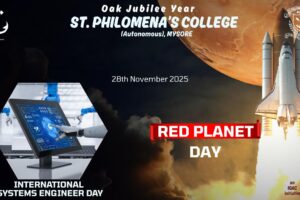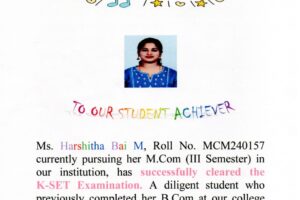
A Report on the Visit to the Oriental Research Institute
The Department of History at St. Philomena’s College organized an insightful visit to the Oriental Research Institute on 16th October as part of an experiential learning activity. This initiative aimed to bridge theoretical knowledge with practical exposure, benefitting the 19 students enrolled in the open elective paper titled “Introducing to Epigraphy.” The group was guided by faculty members Dr. Prakash Arulappa (Head of the Department) and Dr. Prashanth D.A., both of whom actively contributed to making the visit a valuable academic experience.
The visit was designed to provide the students with firsthand experience in the study of epigraphy—the science of inscriptions. It aimed to enhance their understanding of the historical significance, interpretative methodologies, and preservation techniques involved in working with ancient inscriptions.

Upon arrival, the students were warmly welcomed by the staff of the Oriental Research Institute, a prestigious institution renowned for its extensive collection of ancient manuscripts and inscriptions. They were introduced to several historically significant inscriptions, each carrying the cultural and political legacy of ancient India.
1. Session on Epigraphic Techniques and Preservation
The Librarian of the Institute conducted an in-depth session focusing on:
The historical importance of inscriptions as primary sources for understanding ancient civilizations. The technical aspects of interpreting inscriptions, including deciphering ancient scripts such as Brahmi and Kharosthi.

Methods employed for the conservation and restoration of these inscriptions to ensure their longevity and accessibility for future research.The session allowed the students to observe these techniques in action and understand the interdisciplinary nature of historical research, combining archaeology, linguistics, and conservation sciences.
2. Special Lecture on R. Shamasastry’s Contribution
The Librarian delivered an enlightening lecture on the life and contributions of R. Shamasastry, the scholar who discovered and translated Kautilya’s Arthashastra. The students learned about the challenges faced during the discovery of this ancient treatise and its significance in reconstructing ancient Indian political, economic, and administrative systems. This session served as an inspiration for students, highlighting the dedication required for groundbreaking historical research.
Student Engagement and Reflections
As part of the visit, the students were assigned the task of preparing detailed reports to consolidate their learnings. This activity encouraged them to critically analyze the significance of inscriptions and reflect on the methodologies they observed. The faculty members facilitated discussions, ensuring that the students could connect theoretical frameworks with their practical observations.

The visit to the Oriental Research Institute was an intellectually stimulating experience, offering the students a rare glimpse into the world of ancient inscriptions and manuscripts. It highlighted the importance of preserving our cultural heritage and demonstrated how historical research contributes to our understanding of the past.
This enriching academic excursion not only deepened the students’ knowledge of epigraphy but also fostered a sense of curiosity and commitment to historical studies. It underscored the role of institutions like the Oriental Research Institute in preserving and disseminating India’s rich heritage.


